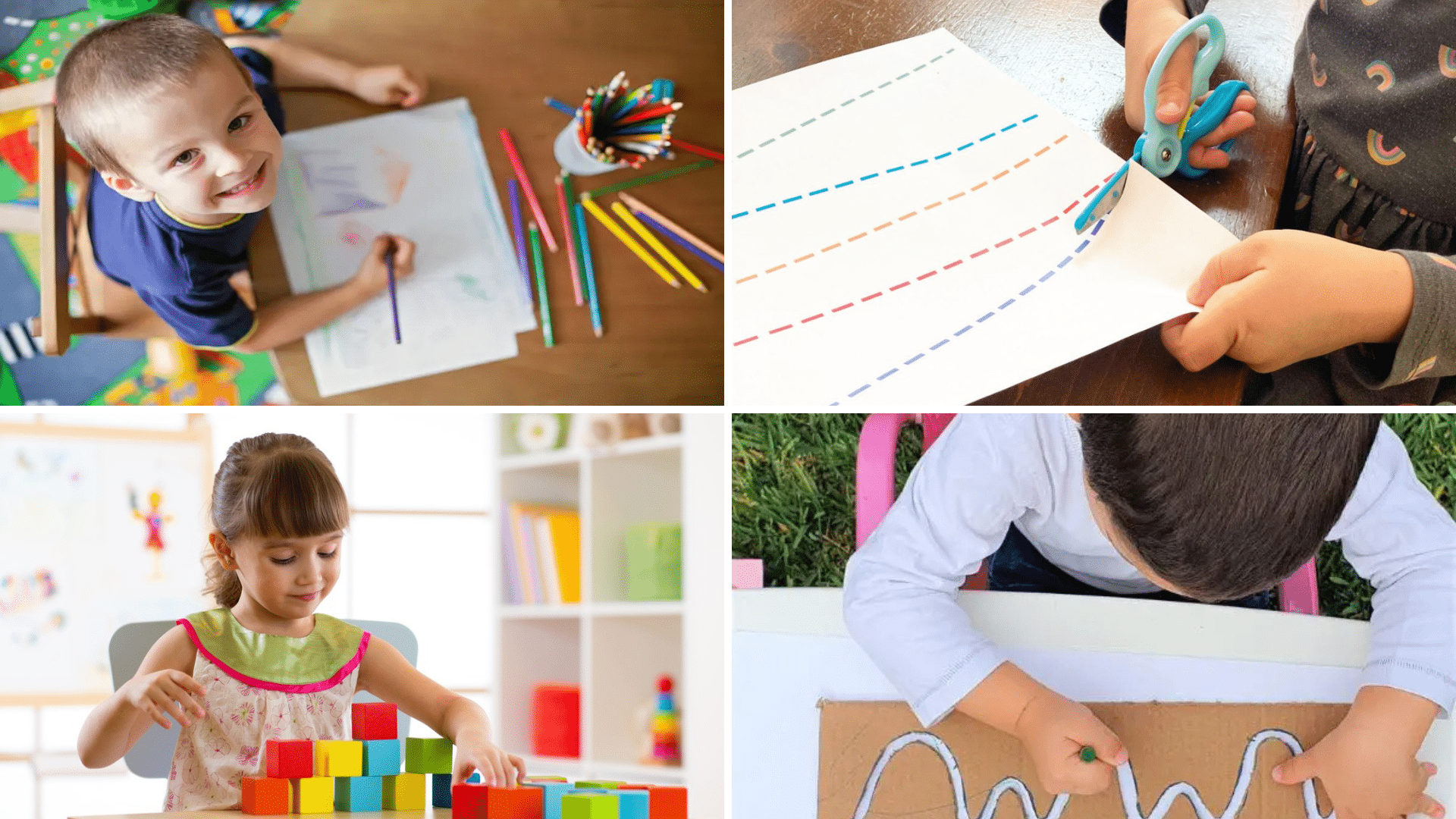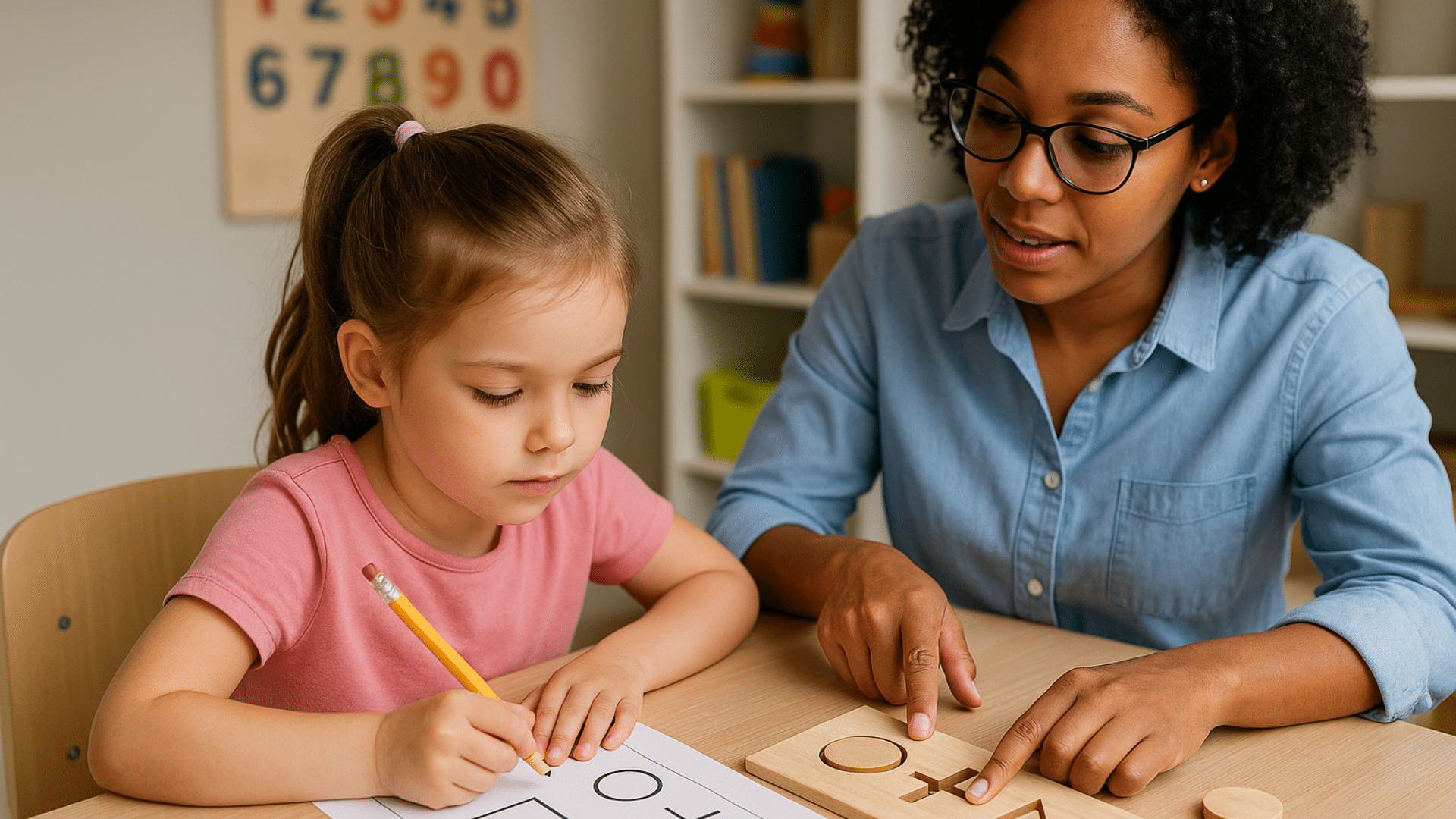Watch a child try to copy a simple shape from the board. Their eyes see it perfectly, but their hand draws something completely different.
Many parents and teachers wonder why some children struggle with tasks that seem simple, like writing letters, cutting on lines, or catching a ball.
Understanding what is visual motor integration helps explain these challenges. This important skill connects what children see with how they move their hands and bodies.
When parents and teachers grasp how visual motor integration works, they can better support children who need extra help with these crucial everyday skills.
What is Visual Motor Integration?
Visual motor integration is the ability to coordinate what the eyes see with hand movements. When children wonder what is visual motor integration, they’re asking about how their brain connects visual information with physical actions.
Strong visual motor integration skills make school tasks like writing, drawing, and cutting much easier.
Core Components:
The essential building blocks that work together to create successful visual motor integration skills in children.
1. Visual Perception
Children see and understand shapes, letters, and objects clearly, with their eyes accurately processing what they’re looking at before their hands can respond.
2. Motor Control
The physical ability to move hands, fingers, and arms smoothly and precisely, giving children good muscle control to hold pencils, cut with scissors, or throw balls accurately.
3. Cognitive Processing
The bridge that connects vision and action, where the brain takes what the eyes see and tells the hands exactly how to move, allowing children to copy homework, build with blocks, or tie their shoes successfully.
4. Eye Movement Control (Oculomotor Skills)
The ability to move eyes efficiently and accurately to gather visual information. This includes smooth tracking across pages when reading, steady fixation on single points, quick saccadic jumps between visual targets, and convergence or divergence to adjust focus for different distances.
Why is Visual Motor Integration Important?
VMI plays a crucial role in children’s daily success at school and at home. Strong visual motor integration skills help kids write legibly, complete math worksheets, and participate in sports activities.
Early identification of what is visual motor integration is and support makes a significant difference in helping children build confidence and succeed in various activities.
Supporting VMI at Home and In School:
- Visual-motor-friendly activities: Simple practice activities like drawing, coloring, cutting with scissors, playing with playdough, and stringing beads help children strengthen hand-eye coordination while having fun
- Classroom strategies: Teachers can provide extra time for writing tasks, break assignments into smaller steps, use larger lined paper, and offer frequent breaks to help students with VMI challenges succeed
- Tools: (slant boards, pencil grips, tracing books) Special equipment like slant boards improves writing posture, pencil grips help with proper finger placement, and tracing books provide guided practice for developing smooth hand movements and letter formation
Common Motor Activities That Reflect or Support Visual Motor Integration

These everyday activities help children strengthen the connection between what they see and how they move, showing parents and teachers what is visual motor integration, in action.
1. Drawing and Coloring
Children use crayons or markers to create pictures and stay within lines. This activity helps kids practice controlling their hand movements while looking at the paper.
Target: Develops fine motor control and hand-eye coordination while strengthening visual perception of boundaries and spatial relationships.
2. Cutting with Scissors
Kids cut along lines, shapes, or free-form patterns using child-safe scissors. They must watch the cutting line while coordinating both hands to operate the scissors.
Target: Builds bilateral coordination, visual tracking skills, and precise finger movements needed for tool manipulation.
3. Tracing Activities
Students follow dotted lines or solid shapes with pencils or fingers. This helps them learn to control their hand movements while following visual guides.
Target: Strengthens visual tracking abilities and develops smooth, controlled hand movements for pre-writing skills.
4. Copying Shapes
Children look at geometric shapes and reproduce them on paper independently. They must remember what they saw and translate it into hand movements.
Target: Integrates visual perception with motor planning to accurately translate what the eyes see into hand movements.
5. Building with Blocks
Kids stack, arrange, and construct using wooden blocks or building toys. They must judge distances and balance while placing blocks in specific positions.
Target: Develops spatial awareness, visual perception of relationships, and fine motor precision for placement and balance.
6. Playing with Play-Dough
Children roll, squeeze, pinch, and shape modeling clay into various forms. This activity strengthens hand muscles while kids create shapes they can see.
Target: Strengthens hand muscles and proprioceptive feedback while developing bilateral coordination and creative expression.
7. Stringing Beads
Kids thread beads onto string or yarn following patterns or color sequences. They must coordinate their fingers to push the string through small holes.
Target: Builds fine motor precision, visual sequencing skills, and hand-eye coordination for small object manipulation.
8. Jigsaw Puzzles
Children fit puzzle pieces together by matching shapes, colors, and patterns. They must rotate pieces and judge how they fit together visually.
Target: Develops visual perception, spatial reasoning, and fine motor control for precise piece placement and rotation.
9. Lacing Cards
Students thread yarn or string through holes around picture outlines. They follow the holes in order while controlling the string with their fingers.
Target: Strengthens pincer grasp, visual tracking, and bilateral coordination while following sequential patterns.
10. Connect the Dots
Kids draw lines between numbered or lettered dots to create pictures. They must find each dot in sequence and draw straight lines between them.
Target: Integrates number/letter recognition with visual tracking and controlled pencil movements for line drawing.
11. Maze Activities
Children trace paths through printed mazes using pencils or fingers. They must look ahead to plan their route while controlling their hand movements.
Target: Develops visual scanning, planning skills, and controlled hand movements while following complex pathways.
12. Handwriting Practice
Students form letters and numbers on lined paper using proper formation. They must remember letter shapes and control their pencil to write them correctly.
Target: Combines visual perception of letter shapes with fine motor control and muscle memory for writing fluency.
13. Threading Activities
Kids push string or yarn through holes in cardboard or plastic templates. They must aim carefully and control the string to pass through small openings.
Target: Builds pincer grasp strength, visual-motor coordination, and sustained attention for detailed fine motor tasks.
14. Paper Folding
Children create origami or simple folded crafts following step-by-step instructions. They must follow visual directions and make precise folds with their fingers.
Target: Develops bilateral coordination, visual processing of spatial relationships, and sequential motor planning abilities.
15. Ball Games
Kids catch, throw, and bounce balls of various sizes during play activities. They must watch the ball and time their hand movements to catch or hit it.
Target: Strengthens gross motor coordination, visual tracking of moving objects, and timing of motor responses.
16. Pegboard Patterns
Students place colored pegs into boards following visual pattern cards. They must match the pattern while placing pegs in specific holes accurately.
Target: Integrates visual perception with fine motor precision while developing pattern recognition and spatial organization.
17. Sticker Placement
Children place stickers on specific targets or within designated areas accurately. They must peel stickers carefully and position them in the right spots.
Target: Builds visual-motor precision, sustained attention, and controlled finger movements for accurate placement tasks.
18. Paint by Numbers
Kids fill numbered sections with corresponding paint colors to create pictures. They must match numbers to colors while controlling their paintbrush movements.
Target: Combines number recognition with brush control, color matching, and visual attention to detail.
19. Copying Patterns
Students reproduce visual patterns using blocks, shapes, or drawings on paper. They must study the pattern and recreate it step by step.
Target: Develops visual memory, sequential processing, and fine motor control for accurate pattern reproduction.
20. Dot-to-Dot Drawing
Children connect numbered dots in sequence to reveal hidden pictures. They must find each number while drawing smooth lines between points.
Target: Integrates number recognition with visual scanning and controlled pencil movements for line formation.
21. Shape Sorting
Kids match and sort geometric shapes into corresponding holes or containers. They must recognize shape differences and orient pieces correctly for fitting.
Target: Builds visual discrimination, spatial reasoning, and fine motor precision for shape matching and manipulation.
22. Tangram Puzzles
Students arrange geometric pieces to form specific shapes or pictures. They must visualize how pieces fit together and manipulate them accurately.
Target: Develops spatial visualization, problem-solving skills, and fine motor control for precise piece placement and rotation.
Signs of Poor Visual Motor Integration
1. Messy or Inconsistent Handwriting Letters appear poorly formed, uneven in size, or have inconsistent spacing between words and sentences
2. Difficulty Copying from Board or Books: The Child struggles to transfer visual information from one location to another, often losing their place or making errors
3. Poor Fine Motor Control: Trouble using scissors accurately, coloring within lines, or manipulating small objects like buttons and zippers
4. Struggles with Visual-Spatial Tasks: Difficulty completing puzzles, mazes, or drawing geometric shapes with appropriate proportions and placement
5. Coordination Issues with Moving Objects: Problems catching or hitting balls, difficulty judging distances, and challenges with activities requiring precise timing
6. Academic Work Organization Problems: Trouble organizing math problems on paper, difficulty aligning numbers in columns, or challenges following visual instructions
Diagnoses & Factors That Influence Visual Motor Integration
Understanding what is visual motor integration helps identify the various medical conditions, developmental factors, and environmental influences that can impact how well children coordinate their vision with hand movements.
Related Diagnoses:
| Diagnosis | How It Affects VMI |
|---|---|
| ADHD | Trouble focusing on visual details; impulsive hand movements |
| Autism | Challenges with sensory processing and motor planning |
| Learning Disabilities | Difficulty translating visual info into motor actions (e.g., writing) |
| Cerebral Palsy | Muscle control and coordination issues affect precise movements |
| Sensory Processing Disorder | Trouble integrating visual/tactile input with motor skills |
Influencing Factors:
- Age: VMI skills develop gradually from toddlerhood through school age, with more complex tasks becoming possible as children mature and their brain connections strengthen.
- Gender: Research shows slight differences in motor preferences and development patterns between boys and girls, though individual variation is more significant than gender differences.
- Home/School Environment: Rich opportunities for drawing, building, and hands-on activities support VMI development, while limited exposure to these experiences can slow skill growth.
- Medical or Vision Issues: Conditions like strabismus (crossed eyes) or amblyopia (lazy eye) can affect depth perception and visual clarity, making VMI tasks more challenging.
When to Seek Professional Help

Seek professional help when symptoms persist for more than two weeks, interfere with daily activities, or when you feel unable to cope despite trying self-care strategies.
- The child consistently has difficulty with handwriting, copying, or visual worksheets that impact school performance.
- Trouble with buttoning clothes, using utensils, or tying shoes well past typical development milestones.
- Shows frustration, anxiety, or refuses to participate in drawing, writing, or hands-on activities.
- Skills don’t develop despite regular chances to practice fine motor and visual tasks at home and school.
Bottom Line
Understanding what is visual motor integration that opens doors to better supporting children’s development.
When parents and teachers recognize how vision and movement work together, they can spot challenges early and provide the right help. Simple activities like drawing, cutting, and building blocks make a real difference in strengthening these important skills.
Remember, every child develops at their own pace. Some need extra support, and that’s perfectly normal. The key is providing plenty of opportunities to practice and seeking professional help when needed.
What activities have helped your child with visual motor skills? Comment below!


















